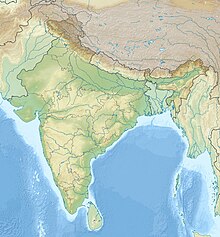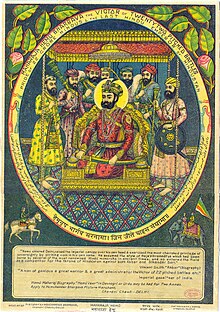| Revision as of 09:52, 29 August 2021 editArjayay (talk | contribs)Autopatrolled, Extended confirmed users, Page movers, Pending changes reviewers, Rollbackers627,140 edits Undid revision 1041203867 by 59.91.105.66 (talk) UnsourcedTag: Undo← Previous edit | Revision as of 07:51, 30 August 2021 edit undo2409:4042:2308:40dc:7982:5ccd:69b1:a742 (talk)No edit summaryTags: Visual edit Mobile edit Mobile web editNext edit → | ||
| Line 10: | Line 10: | ||
| | map_relief = 1 | | map_relief = 1 | ||
| | result = Mughal victory | | result = Mughal victory | ||
| | combatant1 = ]] | | combatant1 = ] ] | ||
| | combatant2 = ] | | combatant2 = ] | ||
| | commander1 = {{ubl | | commander1 = {{ubl | ||
| Line 31: | Line 31: | ||
| | casualties1 = Minimal | | casualties1 = Minimal | ||
| | casualties2 = 5,000 | | casualties2 = 5,000 | ||
| | conflict = | | conflict = Second Battle Of Panipat | ||
| }} | }} | ||
Revision as of 07:51, 30 August 2021
| Second Battle Of Panipat | |||||||
|---|---|---|---|---|---|---|---|
 The defeat of Hemu, a c. 1590s painting by Kankar of the Second Battle of Panipat taken from the Akbarnama. | |||||||
| |||||||
| Belligerents | |||||||
|
| Suri Empire | ||||||
| Commanders and leaders | |||||||
| |||||||
| Strength | |||||||
|
10,000 cavalry 200 War elephants |
30,000 cavalry 500 War elephants | ||||||
| Casualties and losses | |||||||
| Minimal | 5,000 | ||||||
 | |||||||
The Second Battle of Panipat was fought on 5 November 1556, between the Hindu emperor of north India, Hemu, and the forces of the Mughal emperor Akbar. Hemu had conquered the states of Delhi and Agra a few weeks earlier by defeating the Mughals led by Tardi Beg Khan at the Battle of Delhi and proclaimed himself Raja Vikramaditya at a coronation in Purana Quila in Delhi. Akbar and his guardian Bairam Khan who, after learning of the loss of Agra and Delhi, marched to Panipat to reclaim the lost territories. The two armies clashed at Panipat not far from the site of the First Battle of Panipat of 1526.
Hemu and his forces held the numerical superiority. However, Hemu was wounded by an arrow in the middle of the battle and fell unconscious. Seeing their leader going down, his army panicked and dispersed. Unconscious and almost dead, Hemu was captured and subsequently beheaded by Bairam Khan. The battle ended in a decisive Mughal victory.
Background

Humayun, the successor of Babur, the founder of the Mughal Empire, had lost his inheritance when he was chased out of India by Sher Shah Suri who established the Sur Empire in 1540. Delhi and Agra fell into Sher Shah's hands, but he died soon after in 1545 at Kalinjar. He was succeeded by his younger son, Islam Shah Suri, who was a capable ruler. However, upon his death in 1554, the Sur Empire was caught up in a succession battle and was plagued by rebellion and the secession of provinces. Humayun made use of this discord to recapture what was lost and on 23 July 1555, the Mughals defeated Sikandar Shah Suri and finally regained control over Delhi and Agra.
Islam Shah's rightful successor, his 12-year-old son, Firoz Khan, had been murdered by his maternal uncle, who had taken the throne as Adil Shah Suri. The new ruler was however, more interested in the pursuit of pleasure than in the affairs of his state. Those were largely left to Hemu, an old Hindu associate of Sher Shah Suri from Rewari, who had risen from humble circumstances to become both Adil Shah's Chief Minister as well as the general of the Suri army. He was in Bengal when Humayun died on 27 January 1556. The Mughal emperor's death provided an ideal opportunity to Hemu to defeat the Mughals and reclaim lost territory.
Hemu started a rapid march from Bengal and drove the Mughals out of Bayana, Etawah, Bharthana, Bidhuna, Lakhna, Sambhal, Kalpi, and Narnaul. In Agra, the governor evacuated the city and fled without a fight upon hearing of Hemu's impending invasion. In pursuit of the governor, Hemu reached Tughlaqabad, a village just outside Delhi where he ran into the forces of the Mughal governor of Delhi, Tardi Beg Khan, and defeated them in the Battle of Tughlaqabad. He took possession of Delhi after a day's battle on 7 October 1556 and claimed royal status assuming the title of Vikramaditya (or Bikramjit).
Prelude
On hearing the disastrous news from Tughlaqabad, Humayun's successor, the 13-year-old Akbar and his guardian Bairam Khan soon set off for Delhi. In a stroke of luck, Ali Quli Khan Shaibani (later Khan-i-Zaman), who had been sent ahead with a 10,000-strong cavalry force, chanced upon Hemu's artillery which was being transported under a weak guard. He was easily able to capture the entire train of artillery from the Afghans who abandoned the guns and fled without making a stand. This would prove to be a costly loss for Hemu.
On 5 November 1556, the Mughal army met Hemu's army at the historic battlefield of Panipat. Akbar and Bairam Khan stayed in the rear, eight miles from the battleground.
Formation
The Mughal army was led by Ali Quli Khan Shaibani with his 10,000 cavalry in the centre with Sikandar Khan Uzbak on the right and Abdulla Khan Uzbak towards the left. The vanguard was led by Husain Quli Beg and Shah Quli Mahram and included Bairam Khan's detachment of Turks.
Hemu's army was numerically superior counting among its ranks a 30,000-strong cavalry force consisting of Afghan horsemen and an elephant contingent numbering 500. Each war elephant was protected by plate armour and mounted by musketeers and crossbowmen. Hemu led his army himself into battle, atop an elephant named Hawai. His left was led by his sister's son, Ramya, and the right by Shadi Khan Kakkar. His army was an experienced and confident lot and Hemu had, by this time, been victorious in 22 battles from Bengal to Punjab. In this battle however, Hemu had no artillery.
Battle
Abu'l-Fazl, AkbarnamaTwo armies so collided
That they struck fire out of water;
You'd say the air was all crimsoned daggers,
Their steel had all become solid rubies.
Hemu began the attack himself and loosed his elephants among the right and left wings of the Mughals. Those soldiers who were able to escape the rampage, rather than retreating, chose to veer to the sides and attack the flanks of Hemu's cavalry, pelting them with their superior archery. The Mughal centre also advanced and took up a defensive position before a deep ravine. Neither Hemu's elephant nor his horse units were able to cross the chasm to reach their opponents and were vulnerable to the projectile weapons being fired from the other side. Meanwhile, the Mughal cavalry on their swift mounts had made inroads into the Afghan ranks from the flanks as well as the rear and began targeting the elephants, either slashing at the legs of the great beasts or taking out their riders. Hemu was forced to pull back his elephants and the Afghan attack relented.
Seeing the Afghan attack slackening, Ali Quli Khan led his cavalry out, circling around and falling upon the Afghan centre from the rear. Hemu, monitoring the battlefield from his howdah atop Hawai, immediately hurried to counter this charge. Even after seeing Shadi Khan Kakkar and another of his able lieutenants, Bhagwan Das, go down, he continued to lead counterattacks against the Mughals, running down any who challenged his elephants. It was a desperately contested battle but the advantage seemed to have tilted in favour of Hemu. Both the wings of the Mughal army had been driven back and Hemu moved his contingent of war elephants and cavalry forward to crush their centre. It was at this point that Hemu, possibly on the cusp of victory, was wounded when he was struck in the eye by a chance Mughal arrow and collapsed unconscious. Seeing him going down triggered a panic in his army which broke formation and fled. The battle was lost; 5,000 dead lay on the field of battle and many more were killed while fleeing.
Aftermath
The elephant carrying the unconscious and almost dead Hemu was captured after several hours of finishing the battle and led to the Mughal camp. Bairam Khan asked the 13-year-old Akbar to behead Hemu, but he refused to take the sword to a dead man. Akbar was persuaded to touch Hemu's head with his sword after which Bairam Khan executed him. Hemu's head was sent to Kabul to be hanged outside Delhi Darwaja, while his body was gibbeted on a gate in Purana Quila, Delhi, where he had his coronation on 6 October. Several supporters and relatives of Hemu were beheaded and a minaret was later erected. The painting of this minarette is one of the popular 56 paintings of Akbar's life in his copy of the Akbarnama. A memorial for Hemu was erected at the spot in Panipat where he was beheaded. It is now known as Hemu's Samadhi Sthal.
With the passing of Hemu, Adil Shah's fortunes also took a turn for the worse. He was defeated and killed by Khizr Khan, son of Muhammad Khan Sur of Bengal, in April 1557. The spoils from the battle at Panipat included 120 of Hemu's war elephants whose destructive rampages so impressed the Mughals that the animals soon became an integral part of their military strategies.
See also
Notes
- ^ Sarkar 1960, p. 68.
- . Govt of Panipat https://panipat.gov.in/second-battle/.
{{cite web}}: Missing or empty|title=(help) - Sarkar 1960, p. 66.
- Qanungo 1965, p. 448.
- ^ Chandra 2004, p. 91.
- ^ Sarkar 1960, p. 67.
- Richards 1995.
- Tripathi 1960, p. 175.
- ^ Sarkar 1960, p. 69.
- Roy 2004, p. 76.
- Chandra 2004, p. 92.
- Sarkar 1960, p. 68: Chandra names Hemu's nephew as Ramaiyya.
- Abu'l-Fazl. "Vol II, Chapter XI". Akbarnama. Retrieved 8 July 2016.
- Sarkar 1960, pp. 68–69.
- Sarkar 1960, p. 69: According to Sarkar, the battle was still evenly matched when the random arrow found Hemu.
- ^ Tripathi 1960, p. 176.
- ^ Chandra 2004, p. 93.
- "Hemu's Samadhi Sthal". Haryana Tourism. Retrieved 13 July 2016.
- "Places Of Interest / Hemu's Samadhi Sthal". panipat.gov.in. Retrieved 13 July 2016.
- Tripathi 1960, p. 177.
- Roy 2013, p. 47.
References
- Sarkar, Jadunath (1960). Military History of India. Orient Longmans. pp. 66–69.
- Tripathi, Ram Prasad (1960). Rise and Fall of the Mughal Empire (2nd ed.). pp. 158–77.
- Chandra, Satish (2004). Medieval India: From Sultanate To The Mughals, Part II: Mughal Empire (1526–1748) (Third ed.). Har-Anand Publications. pp. 91–93. ISBN 9788124110669. Retrieved 17 November 2014.
- Qanungo, Kalika Ranjan (1965). Sher Shah and his Times. Orient Longmans. pp. 448–449.
- Richards, John F. (1995). The Mughal Empire (The New Cambridge History of India). Cambridge University Press. p. 13. ISBN 9780521566032.
- Roy, Kaushik (2004). India's historic battles : from Alexander the Great to Kargil. Delhi: Permanent Black. pp. 68–79. ISBN 9788178241098. Retrieved 17 July 2016.
- Roy, Kaushik (2013). "Fazl, Abul (1551–1602)". In Coetzee, Daniel; Eysturlid, Lee W. (eds.). Philosophers of war: the evolution of history's greatest military thinkers. Santa Barbara: Praeger. pp. 43–47. ISBN 978-0-313-07033-4. Retrieved 20 July 2016.
| Emperors | |||||||||
|---|---|---|---|---|---|---|---|---|---|
| Administration |
| ||||||||
| Conflicts |
| ||||||||
| Architecture |
| ||||||||
| See also | |||||||||
| Successor states | |||||||||